Title of paper under discussion
Beitrag zur Lokalisation des musikalischen Talentes im Gehirn und am Schädel (Article on the localisation of musical talent in the brain and on the skull)
Author
Date of publication
1906
Journal
Archives of Anatomy and Physiology, 1906:197–230
Link to original paper (open access)
Overview
This paper describes how the surface shape of a musician’s brain (in this case the 19th century German cellist Bernhard Cossmann) differs from that of non-musicians, so revealing the parts of the brain involved in making music.
Introduction
Bernhard Cossmann, the “Joachim of the violoncello”, was a musician of rare distinction. He was principal cellist for Mendelssohn (Leipzig Gewandhaus, 1847) and Liszt (Weimar Staatskapelle, 1850-52, playing in the premieres of Lohengrin and Tannhäuser), a member of quartets led by Joseph Joachim and Ferdinand David, and chamber music partner of the great pianists of the day, including Brahms, von Bülow and especially Liszt, who described his interpretation of Beethoven’s A major sonata op 69 as ‘utter perfection’. He held professorial posts in Leipzig, Moscow and finally Frankfurt, where his pupils included Carl Fuchs and Victor Herbert, and composed salon music as well as the studies and technical exercises for which he is better remembered today.
Cossmann left a further crucial legacy to the musical world: his brain, which found its way posthumously onto the dissection bench of neurologist Siegmund Auerbach. Famous for a textbook on headaches, Auerbach was also ardently curious about the brains of expert musicians: did they differ from non-musical ones, and if so, how? He had already published several autopsies of well-known musicians’ brains prior to 1910, the year that Cossmann became his freshest subject.
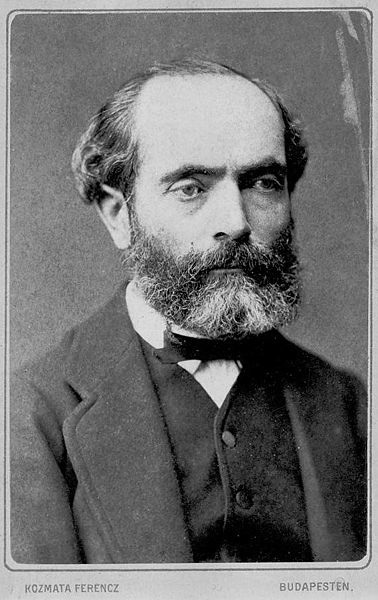
Neuroplasticity
Auerbach’s description of Cossmann’s brain dates from an era of gradual scientific realisation that the human brain might be ‘plastic’, meaning that it develops according to one’s experience. Scientists now know that one type of such plasticity, present mainly at a young age, is structural, meaning that extra tissue grows in brain areas that are being heavily used. String players often start practising their instruments from an early age, so are prime subjects for such plastic changes. By suggesting that the various swellings on Cossmann’s brain were correlated with his expertise as a musician, Auerbach was laying the foundations for research into such plasticity, a modern understanding of which could revolutionise our approach to string players’ education (how and at what age does the brain develop in response to practice?) and their healthy practice regimes (can ‘bad’ practice lead to brain-related movement disorders like focal dystonia?)
Cerebral cortex
Auerbach was especially interested in the appearance of the cerebral cortex, the outer surface of the brain where the highest levels of processing take place and which is so extensive in humans that it is folded in order to be crammed into the skull. These folds, called gyri, are what give the brain its walnut-like appearance; each one is described according to its anatomical location (eg left superior temporal, right inferior frontal), and has function/s attributed to it (eg visual cortex, speech cortex, motor cortex etc). Auerbach was keen to explore whether particular gyri were enlarged in a musician, and so to investigate possible correlations with musical ability.
In Cossman’s brain, he identified six unusually augmented regions (see pictures with explanatory diagrams below):
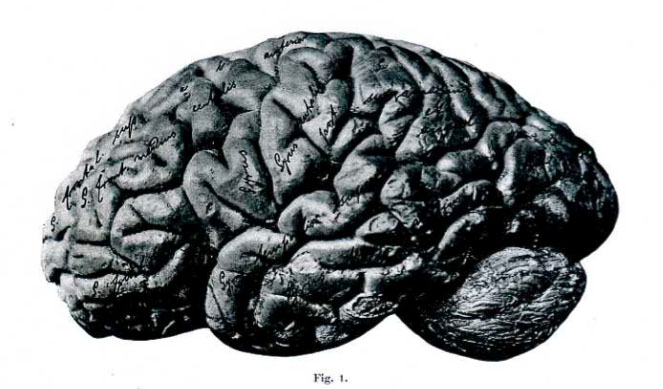
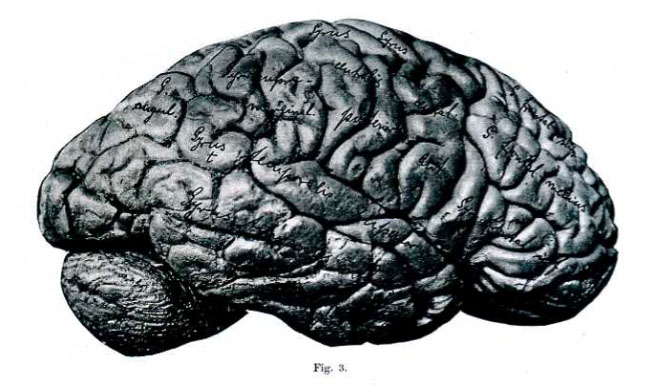
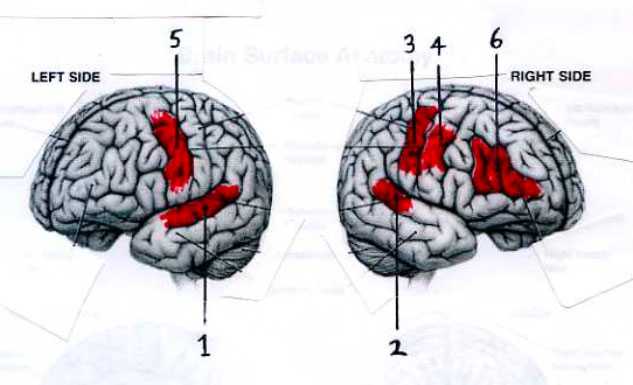
Above: Cossmann’s brain – Areas showing enlargement (and the musicianly functions they serve)
1. Left superior temporal gyrus (hearing)
2. Right superior temporal gyrus (hearing)
3. Right post-central gyrus (left hand/arm sensation)
4. Right pre-central gyrus (left hand/arm movement)
5. Left pre-central gyrus (right hand/arm movement)
6. Right middle frontal gyrus (singing)
The enlargement of Cossmann’s left and right superior temporal gyri, including the Heschl gyri, (see 1 and 2 on diagram) would not have surprised Auerbach – he saw such development in all his musicians’ brains. These areas are part of the auditory cortex, which processes incoming sounds, so any increase in the size of these gyri presumably correlates with an increase in auditory processing power – a self-evidently important musical attribute. Cossmann was apparently so sensitive to pitch that he was never able to experience the same ‘unclouded joy’ playing with the necessarily compromised tuning of a well-tempered piano as he did when singing a cappella or playing with a string quartet. Such enlargement of this brain region is now known to be typical of musicians in general – a study in 2005, led by Peter Schneider from the University of Heidelberg, found that musicians on average have significantly more grey matter than non-musicians in their Heschl gyri. Incidentally, Auerbach also reported that Cossmann’s skull had “vaulting’ temporal bones to accommodate these expanded gyri, a bone structure apparently shared by JS Bach, Beethoven, Haydn, Brahms, Bruckner and Mahler!
Another over-sized gyrus in Cossmann’s brain was the right post-central (3), an area of somatosensory cortex that processes skin and joint sensations from the left side of the body. [Broadly speaking, the right hemisphere of the brain is linked to the left-hand side of the body and the left hemisphere to the right-hand side of the body]. Auerbach conjectured that enlargement of this particular brain area, whose functions includes the sensations of touch and joint angles from the left hand and arm, was related to Cossmann’s outstanding technical accomplishments as a cellist. (Think of this gyrus taking musical wing in Cossmann’s “Studies to develop Agility, Strength of fingers, and Purity of intonation in the Left Hand“)
Recent research supports Auerbach’s speculation: in 1995 Thomas Elbert (University of Konstanz) and colleagues conducted an experiment where they delivered a precisely controlled tactile stimulus – a jet of air – over participants’ left hands whilst scanning their brains to investigate the extent of somatosensory cortex that was thereby activated in the right post-central gyrus. Some of the subjects were string players and others were non-musicians; on average the area of cortex that became active was larger in the string players’ right post-central gyrus compared with that in the non-musicians’ right post-central gyrus.
Also showing extra development in Cossmann’s brain was the right pre-central gyrus (4), an area that includes motor cortex governing left arm and hand movements. So far so unsurprising in a player famed for his left hand agility. However Auerbach found even greater enlargement in Cossmann’s left pre-central gyrus (5), which contains motor cortex governing right arm and hand movements. Were his right hand and arm really more virtuosic than his left?
Auerbach suggested that the reason for this brain asymmetry lay in two facts: firstly that Cossmann was properly ambidextrous, and ambidextrous people don’t have such a strong ‘left hemisphere to right side of body’ wiring as the rest of us. And secondly that he was very skilful at billiards, a game he played right-handed.
I propose another possible reason: that Cossmann was also an accomplished pianist. This is a fair assumption looking at the piano parts of his compositions such as the Fantasias on themes from Euryanthe and Freischutz. Recent studies by Marc Bangert and Gottfried Schlaug in Harvard Medical School (2006) have focused in on the specific region of pre-central gyrus (4 and 5) that controls the hand. This hand-controlling motor region in the pre-central gyrus is visible to neuroanatomists as an inverted omega sign within the fold – they call it the ‘hand knob’. When especially well developed the ‘hand knob’, with its increased cortical volume, can even fold into a double omega. Bangert and Schlaug presented structural MRI images of various pianists’ and string-players’ brains to neuroanatomists and asked them to rate the relative size of left and right ‘hand knobs’. It transpired that pianists more often had a better developed ‘hand knob’ in their left pre-central gyrus (controlling their more virtuosic right hand), whereas non-piano-playing string players more often had a better developed hand knob in their right pre-central gyrus (which controls their left hand). [see figure below]. As Cossmann was an ambidextrous, and presumably piano-playing, string player, it’s perhaps it’s not too unexpected that his pre-central gyri, both of which were enlarged, showed a developmental bias towards the left-hand side of his brain.
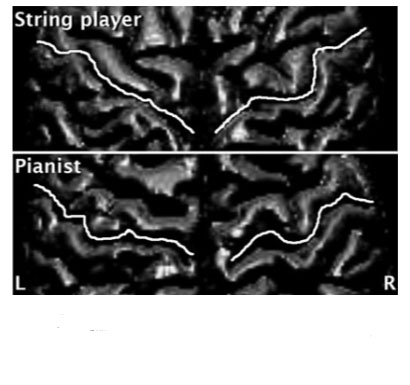
Above: The more fluctuating the white line, the more developed the ‘hand knob’: that part of the motor cortex controlling the hand.
In the string player [top half of figure], the ‘hand knob’ is more developed in the right hemisphere (controlling the left hand)
In the pianist [bottom half of figure] it is more developed in the left hemisphere (controlling the right hand)
[from Bangert and Schlaug, 2006]
Just as his enlarged left pre-central gyrus is a possible clue that Cossmann was gifted at the piano as well as the cello, so his enlarged right middle frontal gyrus (6) may be a clue that he had yet another musical talent – singing. Auerbach relates that Cossmann sang wonderfully as a child, and was able to sing a lower line in duets and trios from the age of 5; he was forced to give up singing later in life due to a throat irritation. Another brain to find its way into Auerbach’s laboratory, four years before Cossmann’s, was that of the famous baritone Julius Stockhausen. Stockhausen also presented with a grossly enlarged middle frontal gyrus (though his was on the left hemisphere). Auerbach knew from contemporary research literature, which looked at the effect of disease in that region of the brain, that this particular gyrus seemed to be associated with singing ability, a finding consistent with present-day studies.
Relevance for today’s musicians
By investigating these peculiarities of eminent musicians’ brains, Siegmund Auerbach was at the vanguard of a field of scientific research into this phenomenon now known as brain plasticity. He suspected, correctly as it turns out, that human brains are plastic in that they develop according to their surroundings and the tasks they undertake. Cossmann had this brain because he was a cellist, rather than being a cellist because he had this brain. In other words, the differences commonly seen in a string player’s brain develop because of practice; they are not present from birth.
The understanding of brain plasticity is important to the string-playing fraternity for two major reasons. The first of these is education. The strong consensus amongst neuroscientists is not only that these structural differences develop through practice, but that there is a critical period of age, during which these developments take place most markedly. (Such critical periods of development in the human brain are not peculiar to string playing but also apply to other accomplishments such as the acquirement of a new language.) The question then arises: what is the age of that critical period of brain development for string players, an age after which the sorts of structural changes we saw present in Cossmann’s cerebral cortex do not take place so readily?
Recent research suggests this critical period for such gross structural changes ends early on in life, around seven years of age. A 1997 study by Katrin Amunts (Heinrich Heine University, Dusseldorf) et al looked at the length of the pre-central gyrus (governing hand movement) in pianists and found that the earlier they had started their musical training, the longer was that gyrus. The 1995 study by Elbert et al (blowing jets of air onto string players’ hands whilst scanning their brains to investigate the extent of hand sensory cortex) found a correlation between the youth of the players when first learning their instruments and the extent of activity in that hand sensory cortex. Another piece of research, by Gottfried Schlaug and colleagues, looked at the enlargement of the corpus callosum – a bundle of fibres connecting the right and left sides of the brain – in response to learning a musical instrument; they showed that structural.changes in this region only came about in musicians whose training had begun before the age of seven.
Moreover, other studies on musicians’ brains suggest that the age of starting the instrument not only affects the development of that particular skill at that particular time, but also determines how well the brain will respond to learning demand on that instrument later on in life – so-called meta-plasticity, or learning to learn.
The changes described by Auerbach seem to be due to structural plasticity, by which the brain develops in a structurally different way in response to demands placed on it. Scientists now recognise another type of plasticity, functional plasticity, where a given brain region takes on a particular function according to the demands on it. For instance, in a blind person the visual cortex will take on the role of somatosensory cortex; or in a person with an amputated limb, those parts of motor cortex that used to control the lost limb will be re-wired to control other muscles that are still in use. This brings us to the second reason why string players might benefit from research into brain plasticity. Functional plasticity can, in string players, have a darker side: the development of focal dystonia. Focal dystonia is a movement disorder that can end string players’ careers, most commonly occurring in their left hands. Each finger of the left hand should have its own individual area representing it in the sensorimotor cortex; focal dystonia comes about when one individual area of sensorimotor cortex starts to appropriate a neighbouring area, a maladaptive form of functional plasticity. When one finger area encroaches on a neighbouring finger’s area, the consequences for the attempted individual control of those digits involved are dreadful.
Conclusion
Auerbach’s study of Cossmann’s brain, which to some of his contemporaries would have seemed like an attempt to rationalise phrenology, helped to lay the foundations for the study of brain plasticity, a field of research which will surely prove invaluable in our profession’s quest to work out the best early years strategies for teaching, and for working towards a cure for the crippling disorder of focal dystonia. Bernhard Cossmann, a truly great cellist who was also the dedicatee of Piatti’s “Twelve Caprices”, may yet be proven to have given his most telling performance post mortem.
Coda
Erlkönig (Franz Schubert), arranged for solo cello by Bernhard Cossmann (1890)
Solo cello – Jeremy Findlay